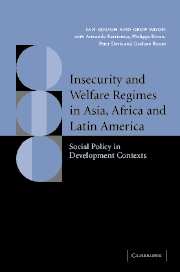 Insecurity and Welfare Regimes in Asia, Africa and Latin America
Insecurity and Welfare Regimes in Asia, Africa and Latin America Published online by Cambridge University Press: 04 August 2010
Introduction
In this chapter I use the in/security model developed in chapter 3 to analyse insecurity and welfare on the continent of Africa. The in/security model has five main components: the structural relationships and dynamics involved in the generation of insecurity; mobilisation outcomes; rectification mix; in/security outcomes; and stratification outcomes. It can be used to analyse regimes in long-term equilibrium, regimes in short-term equilibrium (‘regime episodes’, which can often only be identified retrospectively) and regimes in transition (often involved in ‘contentious episodes’ (McAdam et al. 2001)). As discussed in chapter 3, the model potentially allows for five ‘spaces of comparison’ across the five components, and a thorough analysis would make the comparison across all five spaces. However, in a chapter of this size it is not possible to do such an analysis covering all fifty-three African countries involved in processes of post-colonial transition. Furthermore, given the problems with data on welfare mix and welfare outcomes (which are discussed below), quantitative comparisons across these two spaces, of the kind made in the Latin America and East Asia chapters, would be difficult. In any case, I would argue that, in current African conditions, comparisons across the other three spaces lead to more interesting and policy-relevant conclusions. As a result the structure of this chapter differs from that of chapters 4 and 5.
Tilly has suggested that understanding of ‘big structures’ and ‘large processes’ can be generated by a number of different approaches to comparison.
To save this book to your Kindle, first ensure [email protected] is added to your Approved Personal Document E-mail List under your Personal Document Settings on the Manage Your Content and Devices page of your Amazon account. Then enter the ‘name’ part of your Kindle email address below. Find out more about saving to your Kindle.
Note you can select to save to either the @free.kindle.com or @kindle.com variations. ‘@free.kindle.com’ emails are free but can only be saved to your device when it is connected to wi-fi. ‘@kindle.com’ emails can be delivered even when you are not connected to wi-fi, but note that service fees apply.
Find out more about the Kindle Personal Document Service.
To save content items to your account, please confirm that you agree to abide by our usage policies. If this is the first time you use this feature, you will be asked to authorise Cambridge Core to connect with your account. Find out more about saving content to Dropbox.
To save content items to your account, please confirm that you agree to abide by our usage policies. If this is the first time you use this feature, you will be asked to authorise Cambridge Core to connect with your account. Find out more about saving content to Google Drive.